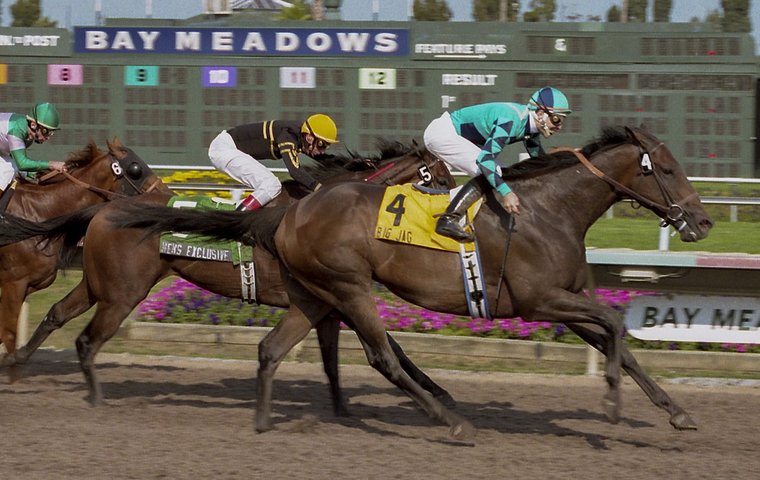
In his latest trip down memory lane recalling his personal favorites, Jay Hovdey remembers the well-travelled giant sprinter who lit up the desert in Dubai
How big is too big? A Humvee stretch limo? Too big. Thanksgiving dinner at your Scandinavian gram’s? Too big. The Grand Canyon? Way too big.
Big Jag was a big, quality Thoroughbred who defied his size. He was cut from the same rare mould as such contemporary stars as Zenyatta and Midnight Lute, horses who brought 17hh into the frame along with a proportionate amount of weight. Their jockeys, strapped on tight, experienced the same headlong rush as a truck driver at the wheel of a semi hurtling downhill on f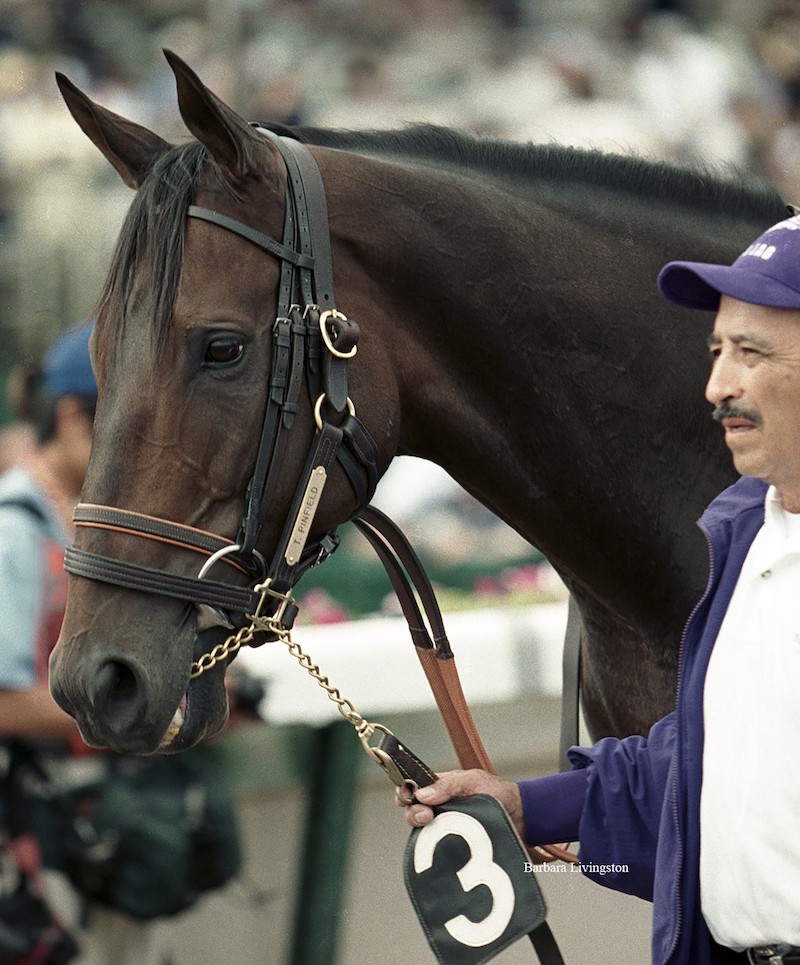 aulty brakes.
aulty brakes.
For 30 months, between August 1998 and early 2001, a significant sector of the sport went directly through Tim Pinfield’s freshly minted southern California stable, where Big Jag reigned as part family pet, part A-list racing celebrity.
Although most readily identified with his native state of California, the gelding roamed far and wide, with appearances in New York, Florida, Hong Kong, and Dubai punctuating his 21 starts during that stretch. From those he won 11 times – nine in stakes – with another five placings to remind opponents that he was always game for a battle.
“He wouldn’t look out of place walking out of the paddock at Cheltenham,” said Pinfield, a native of Worcestershire in England’s West Midlands. “He was a millimetre below 17hh and just below 600 kilos. That’s a chunk of a horse. If he’d kept his manhood, god forbid how heavy he would have got.”
Pinfield, 56, knows whereof he speaks. At around 1,300 pounds, Big Jag would have blended nicely with the monsters of jump racing. In his ambitious youth, Pinfield spent six years riding professionally, both jumps and Flat, while notching a couple of minor wins over the hallowed Cheltenham turf before California called and a job with Charlie Whittingham.
There followed a productive period in the 1990s with trainer Darrell Vienna, whose stable was stocked not only with domestic aces like Gilded Time and Belle’s Flag, but also a collection of modest Europeans whose reputations were enhanced by a fresh US venue. By the summer of 1997 Pinfield was on his own, winning at first crack with the sprinter White Bronco, formerly trained by Vienna.
At the time, Big Jag was in the midst of a long recuperation. His first eight races at ages three and four were spread between the respected Thomas Bunn Jr. and Vienna. Big Jag won twice, but his knees could no longer support his bulk as he matured, as both a physical specimen and a professional racehorse.
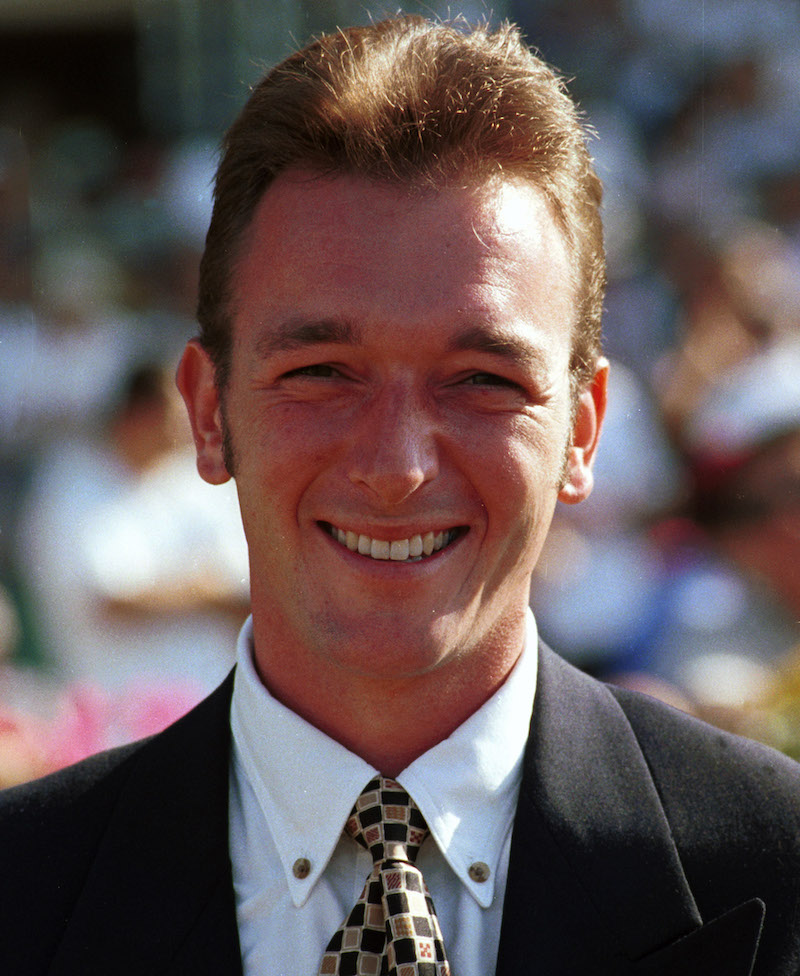
“I knew him well from my time with Darrell,” Pinfield said. “He’d been off a year and a half when he came to me from the farm.”
Nothing to lose
There really was nothing to lose. Big Jag was little more than a huge slab of marble, at which any trainer would need to chip away to reveal whatever image was lurking inside.
In his reappearance for Pinfield, Big Jag turned up in a sprint at Del Mar with a $40,000 claiming tag attached that essentially read, “Go ahead, I dare you.”
It would have taken a brave owner or trainer to spend that kind of money on a gelded, five-year-old moving van of a Thoroughbred known far and wide to have surgically repaired knees that sometimes crackled like Rice Krispies.
“It was quite common knowledge that he’d had some problems and some surgery,” Pinfield said. “I thought we had a pretty good chance to get away with it. And I thought it would take a pretty good horse at that level to beat him.
“Then when the gates opened he fell. And he was on his chest! Rene Douglas did a great job just staying in the tack. So he’s last, then he gets up to win going away. That was an exciting day.”
Handsome reward
Big Jag also paid off at odds of 15-1, a handsome reward for the faithful. And he was not claimed. “Three weeks later he wins an allowance race and everyone’s saying, ‘Yeah, I was gonna claim that horse,’” Pinfield said, still amused at the age-old racetracker’s lament.
Big Jag completed his five-year-old resurrection by winning one-turn sprint stakes for California-breds at Santa Anita, Bay Meadows and Hollywood Park. He would squeeze out of the gate, lag back early, then come with a thundering finish to take the lead at the eighth pole and draw off with style. By then, Jose Valdivia, a second-generation rider from Peru who came to the US as a child, had become part of the team.
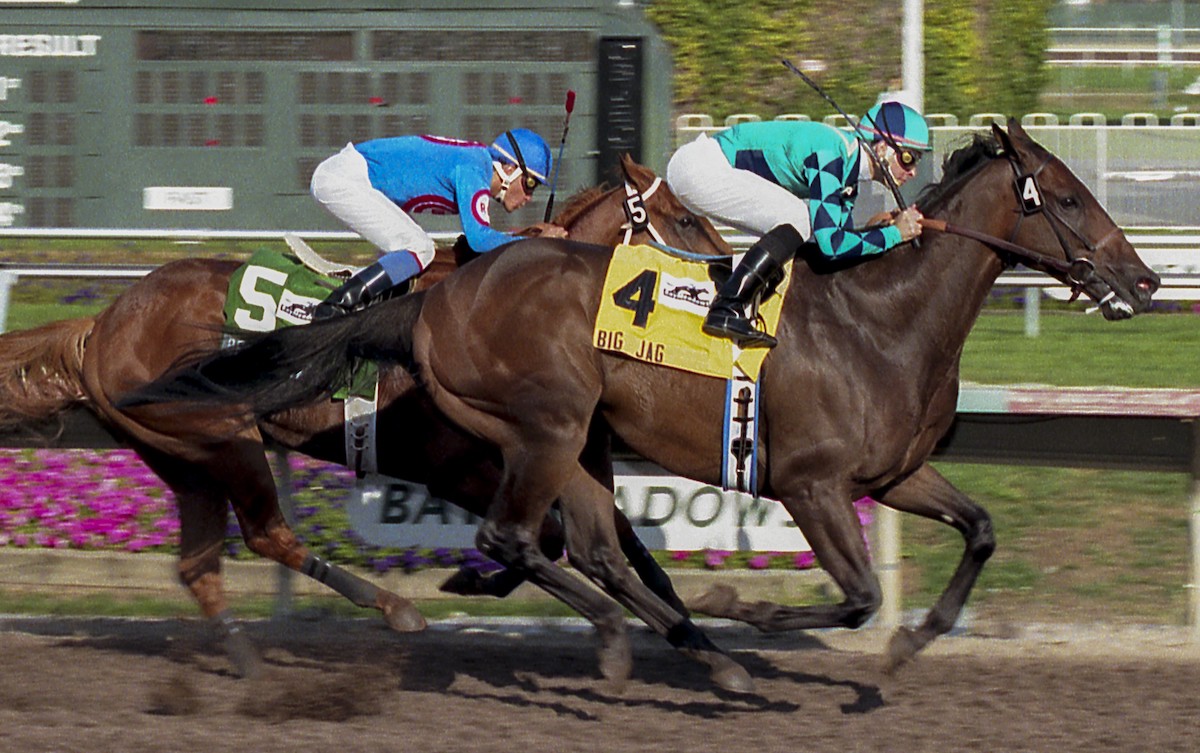
“Until this day, he’s the biggest horse I’ve ever been on, not only in height, but in width,” Valdivia said. “If I set my irons like any other horse, my knees felt like they were in my face. When he loaded in the gate he barely fit. I was almost rubbing against the guy in the gate with him. He had to bow his neck a little bit, and that’s why he was always slow away from there.”
Valdivia was a New York apprentice at the start of his career in 1994. There followed several vagabond seasons during which he became a familiar face at 20 different racetracks, from Fairplex Park in southern California to Florida’s Hialeah Park in its waning days.
As 1998 dawned, Valdivia was gaining a solid reputation as a stylish, reliable talent, but to that point he had yet to corral a breakthrough stakes-winner he could ride to new heights. Big Jag filled the bill, and then some.
“As big as he was, I couldn’t believe he was such a good sprinter,” said Valdivia, who counts a Breeders’ Cup and a Belmont Stakes among his nearly 2,000 career wins, through mid-February 2023.
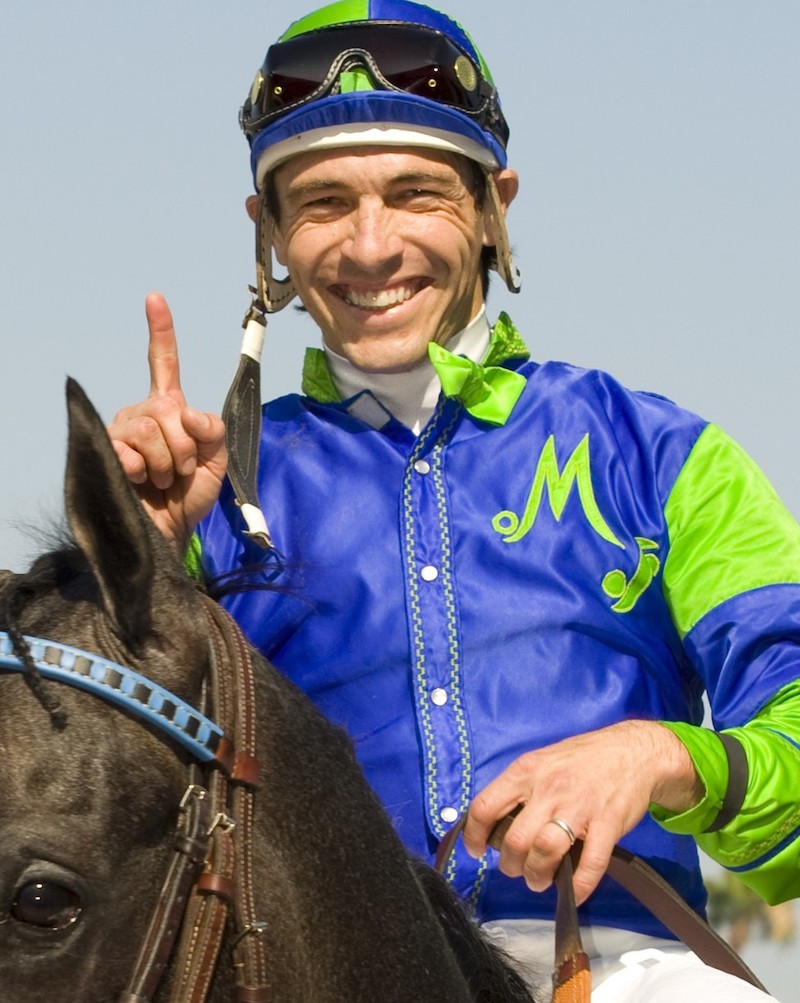 “When I got the mount from Rene Douglas, he told me when you ride him just help him get out of the gate. Don’t send him, because it will take him a few strides to get going. But when you want to let him go, make sure you’ve got room, because if you don’t he’ll run over somebody.”
“When I got the mount from Rene Douglas, he told me when you ride him just help him get out of the gate. Don’t send him, because it will take him a few strides to get going. But when you want to let him go, make sure you’ve got room, because if you don’t he’ll run over somebody.”
Beginning with their victory in the California Sprint Championship at Bay Meadows on Oct. 3, 1998, Valdivia was aboard Big Jag for 14 consecutive races. Ask for the most vivid memories, and he will quickly recall their second encounter in the Cal Cup Sprint at Santa Anita on Oct. 31, 1998.
“It was a big field, and running off the turn I was down on the inside,” Valdivia said. “When I let him run at the eighth pole I got him completely stopped. A little hole was there and then gone. That’s it, I thought. I’m done. Then I found another hole past the sixteenth pole, and I don’t know how he did it, but he got out and won. I didn’t even have time to hit him. I could only think, ‘Wow!’”
His patrons echoed the sentiment. Big Jag was bred and owned by Julius Zolezzi, a member of a legendary family of tuna fishermen in San Diego. While the uninitiated thought the name of his horse conjured a large cat or a powerful car, the term ‘big jag’ actually describes a huge bounty of tuna caught in one haul. Through the generations, the Zolezzi tuna fleet had caught more than their share.
Because of environmental regulations – primarily in the protection of dolphin snared in tuna nets and shifting migratory patterns – the southern California tuna industry underwent dramatic changes.
The Zolezzi family sold their interests, and by the 1990s it was a small but entertaining stable of Thoroughbreds that kept Julius busy with mares and matings. “Our whole family loved racing,” said John Zolezzi, Julius Zolezzi’s son. His father died in 2022, at age 91.
“As kids we’d go to Del Mar every summer,” John continued. “My grandfather would buy us ice cream, but it was our grandmother who was really into playing the horses. Until Big Jag came along, my all-time favorite horse was Affirmed.”
Connection to both Affrimed and Alydar
In Hopes, the dam of Big Jag, is a daughter of Affirmed from the second crop of the 1978 Triple Crown winner and two-time Horse of the Year. She was purchased privately by the Zolezzi family in 1992 while in foal to the Alydar stallion Kleven.
Entwining the bloodlines of Affirmed and Alydar always was fraught with history. The two contemporaries staged what is easily the greatest North American rivalry of the late 20th century. Even though Affirmed won more decisions, there was rarely much between them at the end of their 10 encounters during the memorable seasons of 1977 and 1978.
Georgia Ridder, the breeder of In Hopes, was fully justified in choosing the name for the filly. Her dam was Cascapedia, a daughter of Chieftain who raced to a national championship in 1977 for Ridder and her late husband, Ben Ridder. Their stellar collection of stakes winners included Flying Paster, Modus Vivendi, Messenger Of Song, and Winter Solstice, while their name lives on in publishing circles as half of the Knight-Ridder enterprise.
In Hopes was the third foal of Cascapedia. She was a yearling when Cascapedia’s second foal, the colt Glacial Stream, quite by chance won the 1983 Affirmed Handicap at Hollywood Park. As omens go, that was pretty good. But despite the best efforts of trainer David Hofmans, In Hopes could win only a maiden race in 11 starts. An injury ended her racing career in early 1987.
After producing four fillies of modest ability, In Hopes was sent to Kleven. As a racehorse, Kleven was even more fragile than In Hopes, going forth only three times in California for owner Charlene Parks and trainer Henry Moreno. Kleven, named for a family friend, at least finished first, second, and third in those three minor events, and his dam, Strings Attached – from the World War II British hero Tudor Minstrel – had produced the first-class speed filly Raise Your Skirts.
But that was hardly enough to earn him a robust roster of mares when he retired to stud in California. Big Jag was one of only seven registered Kleven foals of 1993.
As it turned out, Big Jag favored neither the lithe, streamlined Affirmed nor the heavier, Roman-nosed Alydar, both of them shades of chestnut. In Hopes foaled her Kleven colt for the Zolezzis on April 22, 1993, at Flag Is Up Farm in Buellton, California.
“I’ll never forget the call we got from the man at the farm,” John Zolezzi said. “The first thing he said was, ‘Oh, my God, this foal is big!’ There was no resemblance to Affirmed, but he did favor his dam.”
Unsuspected rivalry
As the 1999 season dawned in southern California, an unsuspected rivalry began to brew. In the one corner was Big Jag, thriving on mended knees. In the other was Kona Gold, a product of the iconoclastic Bruce Headley who did not start until age four and still managed to finish third a few months later in the 1998 Breeders’ Cup Sprint.
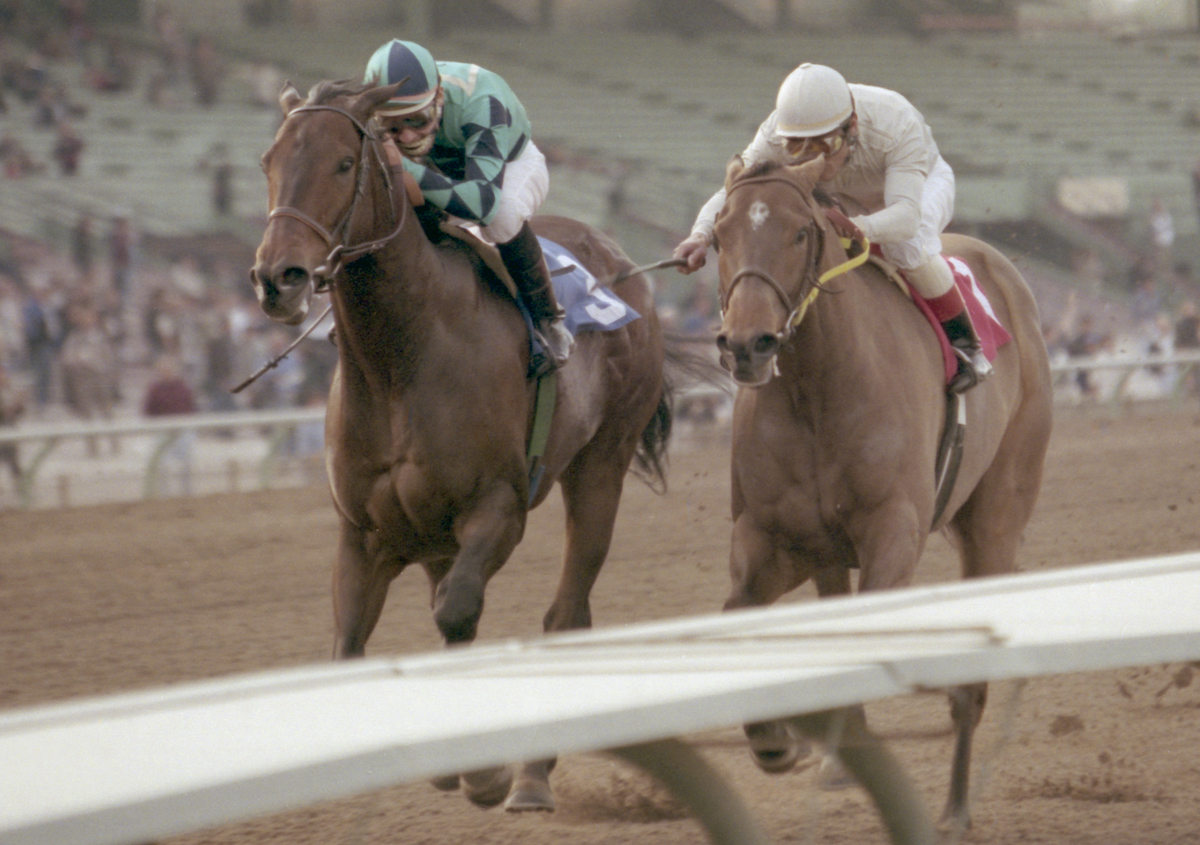 The first punch was thrown by Kona Gold in the El Conejo Handicap at Santa Anita, a listed stakes. At 5½ furlongs, the ever-closing Big Jag did well to finish second. Next came the Palos Verdes Handicap at six furlongs, an even match reflected in Big Jag’s narrow victory, although Kona Gold did give him 5lb in the weights.
The first punch was thrown by Kona Gold in the El Conejo Handicap at Santa Anita, a listed stakes. At 5½ furlongs, the ever-closing Big Jag did well to finish second. Next came the Palos Verdes Handicap at six furlongs, an even match reflected in Big Jag’s narrow victory, although Kona Gold did give him 5lb in the weights.
Their third meeting in the seven-furlong San Carlos Handicap was epic. The deep field of five also included G1 winners Dramatic Gold and Lord Grillo, as well as the estimable Gold Land, age eight and still thriving. There was bumping and careening from the stretch turn to the wire, but in the end Big Jag had half a length on Kona Gold, with Dramatic Gold a similar margin back in third.
“That was fun, two sprinters like that throwing down in race after race,” Valdivia said. “Kona Gold was the kind of horse who could go along in 21, 44 and change, and just keep going. I couldn’t really do anything about it except ride my horse the way he wanted to be ridden.”
Kona Gold remained in the barn for the subsequent Potrero Grande Handicap at 6½ furlongs, which left Big Jag heavily favored but still challenged to finish a neck in front of the ambitious Early Pioneer, who was getting an 8lb break. The race marked Big Jag’s eighth victory in nine starts for Pinfield, putting them both squarely on the national racing map.
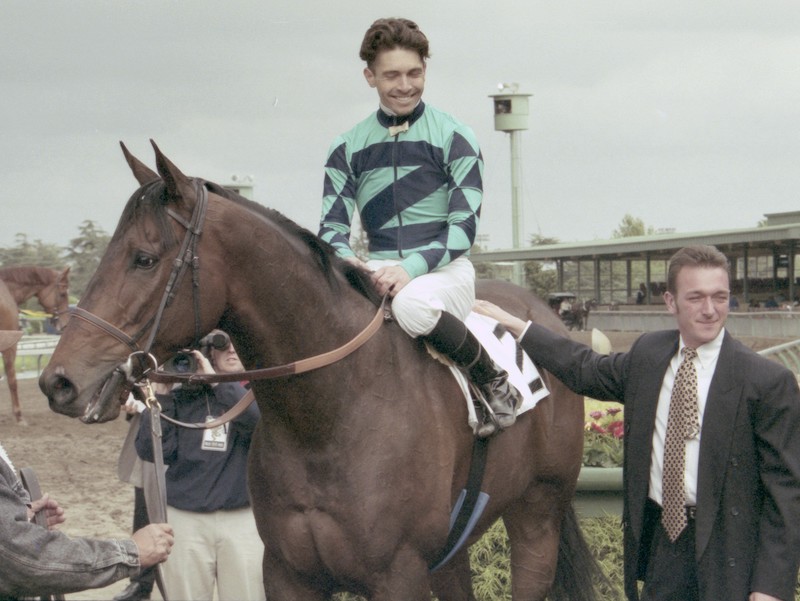 Around the world
Around the world
However, beyond his unusual dimensions, Big Jag would have persisted in the memory as nothing more than a very capable G2 sprinter who was able to overcome a few common but potentially compromising physical infirmities – were it not for three races over a span of about 4½ months that set him firmly apart.
“He took us, quite literally, around the world,” said John Zolezzi.
First came the Breeders’ Cup Sprint on Nov. 6, 1999, at Gulfstream Park over six furlongs. Big Jag was fresh from a pair of sharpening efforts in minor stakes at Bay Meadows.
“It was my first Breeders’ Cup, and I was in with a contender,” Valdivia said. “But I knew the cards were stacked against us. Artax was at the top of his game. Kona Gold was in there. And Gulfstream was a speed-favoring track. Tim said Jag could probably run the best race of his career and still finish only fifth.”
Big Jag did even better, weaving his way between and around opponents from deep in the field of 14 to finish third. Victorious Artax was acclaimed the year’s champion sprinter. Runner-up Kona Gold won the BC Sprint the following year in race record time. The prize for third was $144,000, more than Big Jag had earned in any single gulp to that point.
Big Jag’s Breeders’ Cup performance inspired Pinfield and Julius Zolezzi to even greater ambition. For his 10th and final start of the 1999 season, their horse was sent to Hong Kong for the early December festival of international racing, which included the first running of the Hong Kong Sprint.
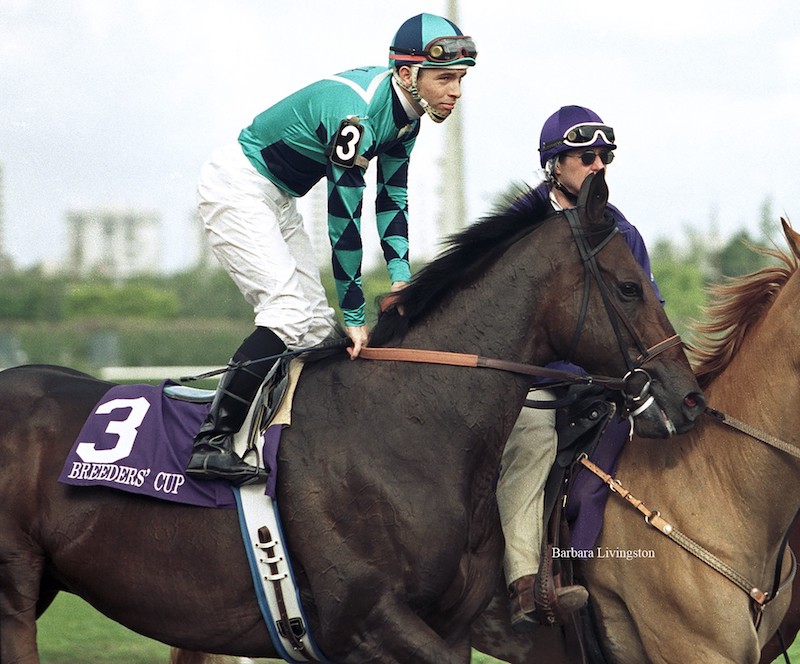 Big Jag was tasked with handling not only a five-furlong grass race on a right-to-left straightaway, among the opposition would be the emerging Hong Kong superstar, Fairy Prawn King.
Big Jag was tasked with handling not only a five-furlong grass race on a right-to-left straightaway, among the opposition would be the emerging Hong Kong superstar, Fairy Prawn King.
“By that time we really had nothing to prove,” Pinfield said. “He was a fun horse, and our thinking was, ‘Let’s enjoy him. Look at the places this wonderful horse can take us.’ I’d been to Hong Kong before, and Mr. Zolezzi was open to suggestions like that.”
Big Jag, on the other hand, appeared as if he was stuck in customs for Sprint’s first half- mile. Then, as if the thought occurred to him, he leveled out and gave Valdivia a blistering final furlong to finish third behind Fairy Prawn King.
“We were flying at the end,” Valdivia recalled. “And here’s a horse who’d never been on grass. His feet are not that big. He’s got no grass pedigree at all. And to this day, I’m convinced if that race is three-quarters, I get up to win.”
In the 1999 Daily Racing Form Free Handicap, Big Jag was rated the fourth best sprinter in North America. To begin his six-year-old campaign in 2000, Big Jag was faced once again with his nemesis in the Palos Verdes Handicap at Santa Anita. Kona Gold beat Big Jag by two lengths, but Pinfield was hardly discouraged. There were bigger fish to fry – half a world away.
Through its first four years, 1996-99, the Dubai World Cup program featured the Nad Al Sheba Sprint, a tidy little straightaway six furlongs that catered to local talent. For the 2000 World Cup celebration, the sprint was transformed into a million-dollar event and christened the Golden Shaheen, honoring the hunting falcon preferred by Dubai’s rulers.
Nothing lost in translation
For the Dubai event, Valdivia was replaced by Alex Solis. All parties attribute the move to the kind of internal politics familiar in every corner of racing, where the most easily interchangeable part – other than blinkers – seems to be the rider. As for Big Jag, he lost nothing in translation.
“It was a tough trip getting there,” Pinfield said. “He went Los Angeles to Amsterdam and had to lay over there a day before going on to Dubai. Once there he was 10 days in quarantine basically doing nothing as we ticked him over gradually to the 12-hour time difference in terms of feeding. But he took everything really well, and I think we got it right.”
They had to, given the influx of solid international talent for that first Golden Shaheen. The opposition included 1999 Haydock Sprint Cup runner-up Bertolini, Hutcheson Stakes winner Bet Me Best, Hungerford Stakes winner Lend A Hand, Richmond Stakes winner Muqtarib, and the G2 Australian winners Dantelah and Notoire.
Such credentials proved meaningless, however. Biding his time, as usual, Big Jag and Solis rallied through the final furlong to win by four lengths in 1:08.10. It was a full second faster than the course record, while setting a standard for the kind of horse required to win the Golden Shaheen for many years to come.
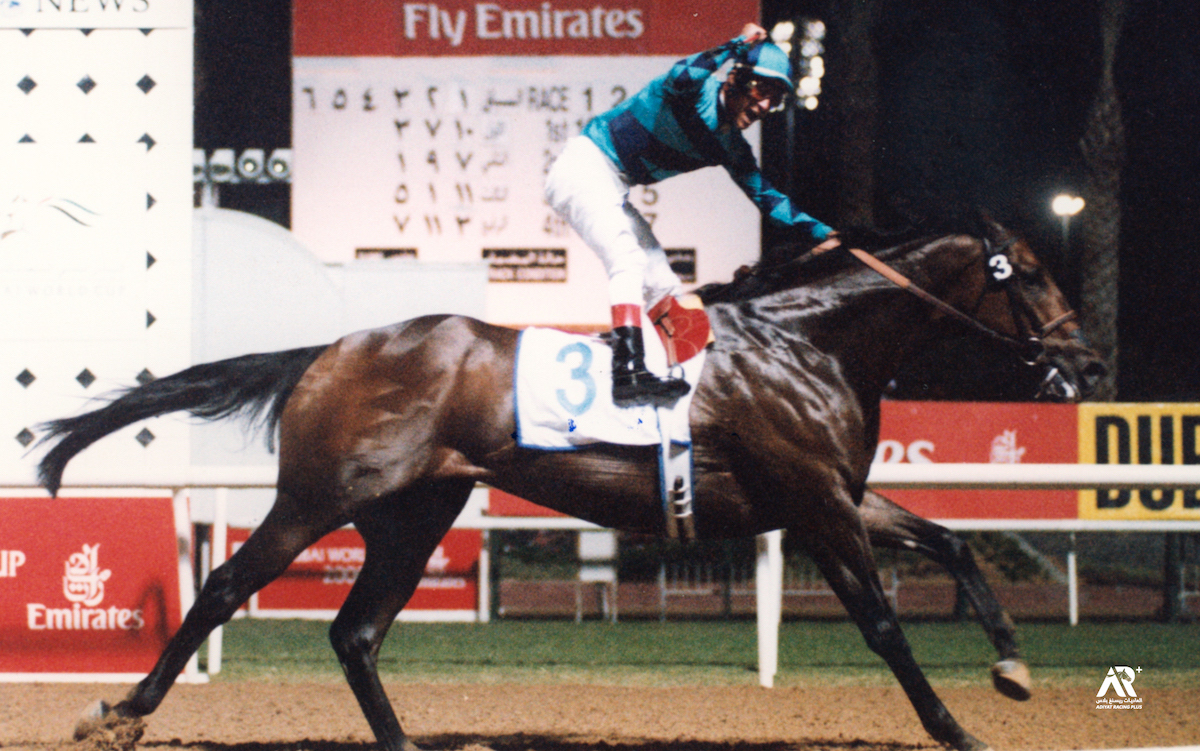 While the superstars Dubai Millennium and Fantastic Light were also victorious on that 2000 World Cup program, Big Jag and Pinfield were greeted back home in southern California as conquering heroes.
While the superstars Dubai Millennium and Fantastic Light were also victorious on that 2000 World Cup program, Big Jag and Pinfield were greeted back home in southern California as conquering heroes.
And the worlds left to conquer were few. After a brief rest, Big Jag tried a mile in the Metropolitan Handicap at Belmont Park but settled for an unthreatening fourth. A subsequent flop in the Triple Bend Handicap at Hollywood Park convinced Pinfield his old warrior needed a rest, which he got. Then, in one last bit of human indulgence, Big Jag’s people decided to try Hong Kong again to see if they could capitalize on lessons learned the first time around. They could not.
“We knew he was getting close to the end of his career,” Pinfield said. “It wasn't so much his age. It was the miles, the wear and tear, but it was the training on those knees. There was only so much more in him. But he did winter well, and his return race in the Palos Verdes was as good as we could have wanted.”
That was January 2001, with Kent Desormeaux now aboard for a second-place finish. Big Jag cooled out like a charm, prompting Pinfield to solidify plans for a defense of the Golden Shaheen title. Once in the UAE, everything went well until a workout two weeks before the March 24 World Cup program.
“It was an awful thing to actually see him take that bad step,” Pinfield said of that morning. “It was a routine sort of work, but you could see him just dip a couple of steps from the line. My first thought was that it was those knees we were always looking after. But it was a sesamoid, in his left-fore.”
Once the injury was stabilized, Big Jag underwent surgery at the equine clinic in Dubai, where the best possible care was available. Pinfield and his crew had to return home without the most important member of their party, and the scene back at Santa Anita was somber.
“It was very hard, especially on my little girls, who visited the barn often and had sort of grown up with the horse,” Pinfield said. “He’d become a part of the family – our family and the barn family. I had to explain where old Jag was, and why his stall was empty.”
At least there was hope. Big Jag handled the post-op period well enough, but he was not yet able to ship home. Then, during the early summer, he began to founder in his opposite leg. Heroic measures were deployed, but to no avail. After constant consultation with the Zolezzi family and Pinfield, the decision to euthanized Big Jag was made on Sept. 24, 2001. His ashes were scattered at Nad al Sheba.
“He put a lot of smiles on a lot of people’s faces,” Pinfield said. “It was truly like losing a friend. We spent so much time traveling around, and because he was a fragile kind of a horse, we spent a lot of hours maintaining him. And look what he did for us.”
• Read all Jay Hovdey's features in his Favorite Racehorses series
Nashoba’s Key: ‘She’d lay back and lunge at you like a viper if you got too close’
Where the clock is king: which are the oldest track records still standing in the US?
New star Lemon Pop fizzes into world Top 50 with Breeders’ Cup Challenge win in Japan
View the latest TRC Global Rankings for horses / jockeys / trainers / sires


